by Cassandra Kuyvenhoven
I’m an open kind of person and I don’t mind sharing stories. I love stories. I think it’s so interesting to collect stories. Often at an art opening, somebody will read a story in one of my books and they’ll say, “that reminds me of…” and then people tell me more stories—their own stories! I collect stories. I collect stories, I collect garbage, I collect fabrics, I collect art: I am the ultimate collector.
-Lise Melhorn-Boe
Lise sits in her living room and proudly points to a large oil canvas that she traded for two of her handsewn cushions. I am captivated. A soft-spoken woman, Lise becomes extremely animated when reading from her treasure trove of books. Amidst the piles of fabrics and refuse, I lean forward to listen to Lise recount stories about dishwashers and used teabags and shockingly sexist nursery rhymes.
There’s something luxurious about being able to touch her books, feel the fabrics, and immerse yourself in the story. As Lise reads me her stories, I am fingering pieces of her old garbage that she has collected into a series entitled Garbage and More Garbage. Sewing her garbage into small mesh bags, Lise has created tiny time capsules that show her life in 2007 and again in 2010 when she was drinking Rice Dream, cooking chicken (she assures me that the bones were triple washed before being sewn into the book) and applying for a new passport (having decimated her old passport into a makeshift cover for the book).
The tactile experience of touching (but thankfully not smelling) her waste-books feels like you’re breaking a taboo—oftentimes waste is meant to be out of sight and out of mind. But Lise is not the type to keep anything hidden: her art is deeply personal and complex.
Oftentimes waste is meant to be out of sight and out of mind. But Lise is not the type to keep anything hidden: her art is deeply personal and complex.
I first met Lise at an art gallery in Ontario, where I was giving a talk on waste transportation in conjunction with an environmentally-themed art exhibit. As my talk ended, a willowy woman rushed up to me and said she was an artist who loved garbage, and that I should call her sometime to talk trash. She pushed a rather plain-looking card into my hand and quickly scurried off, leaving me in a stunned silence. If she told me her name at the time, I can’t recall.
But I held onto that card for several years, fascinated by the strange encounter. Having thought of Lise after seeing a particularly artful bundle of trash on the street during the winter thaw, I looked her up on her website and was pleased to see that she loved more than just garbage. One of her pieces, There Once Was A Little Boy/Girl, consists of handmade paper outfits for that are rubber-stamped with nursery rhymes about girls and women, and boys and men. The final nursery rhyme for boys says:
Tommy Trot, a man of law
Sold his bed and lay upon straw.
Sold the straw and slept on grass,
To buy his wife a looking glass.
In contrast, the nursery rhyme for girls reads:
See-saw Margery Daw
Sold her bed and lay upon straw
Was she not a dirty slut
To sell her bed and life in the dirt.
I was shocked when Lise read me the rhyme—in part because of the language (they let children read these rhymes?) but also because of the shamefulness of a woman getting dirty in her environment. I asked Lise why she thought it was commonplace or noble (in the context of the rhyme) for a man to lie on the ground and what made the same action unclean for a woman. She said that there is a stark contrast between what is acceptable for a woman to do in her environment—how she is able to relate to nature and her surroundings—and what a man can do in his environment. We sat quietly, pondering this dichotomy. That is what’s so special about Lise’s work—she reveals the complex factors and processes that shape women’s lives and their interactions with the environment, while also challenging the audience to question their opinions and beliefs about how individuals experience nature. In exploring these ideas, Lise tells an accessible and engaging story that you just can’t help but put your hands on.
Could you speak a little bit about how your relationship with the environment has influenced your art?
The series about the relationship between environment and human health started when I got breast cancer. I went out to British Columbia to see a naturopath who had a live-in program—I went for 10 days. He did a medical history, a life history and found out that I had grown up in a mining and smelting town in north-western Québec and then attended high school in Copper Cliff3, Ontario—another smelting town which has the Inco Superstack4. As soon as he found this out he said, “I’m going to do a heavy metals test”. And I did indeed have very high levels of lead and mercury and all kinds of heavy metals. So he believed that the heavy metals in my body were quite possibly the cause of my breast cancer.
So then I thought that there must be other people who are being affected by the environment too, and I was lucky enough to stumble upon a residency at Queen’s University in Kingston, Ontario—so I spent four months as an artist in residence at Queen’s through the Principal’s Fund. I didn’t actually make any art; I just did research in the libraries! I found out as much as I could about how our environment is affecting our health. And so one of the things I came across was the garbage. I did garbage first.
As a waste researcher, I am absolutely obsessed with waste. I am the person that you’ll see on the sidewalk stooping into people’s trashcans to get the perfect garbage picture. How did you start thinking about integrating garbage into your art?
My garbage series began with a piece that I made in 2007 called Garbage, where I put all of my daily garbage into individual mesh bags. Each bag contains one day’s worth of garbage. Now, this obviously does not include personal wastes with any bodily fluids. And it’s nothing that I could compost or recycle—so this is what is left, what remains. Mostly it is plastics. There are some bones that were washed carefully and bleached—even though that’s maybe not necessarily all that environmentally friendly in itself.
These purple plastic mesh bags that I used—one of the grocery stores in North Bay had just started carrying organic produce and when I bought the organics, they were putting it in these mesh bags! I didn’t throw any of them out; I saved a whole bunch of them and gave them to my friend who was a weaver because she thought she could try using them to weave grocery bags.
But then I was collecting more and more of these plastic mesh bags, so I thought they would be the perfect vessel for even more plastics. I made these bags—it’s an edition of five. For five weeks in the summer, I had all of these little plastic bags scattered around my studio floor. And then, as you can see, I’ve quilted the waste with a sewing machine to keep the contents together. Then I’ve hand-sewn the text on.
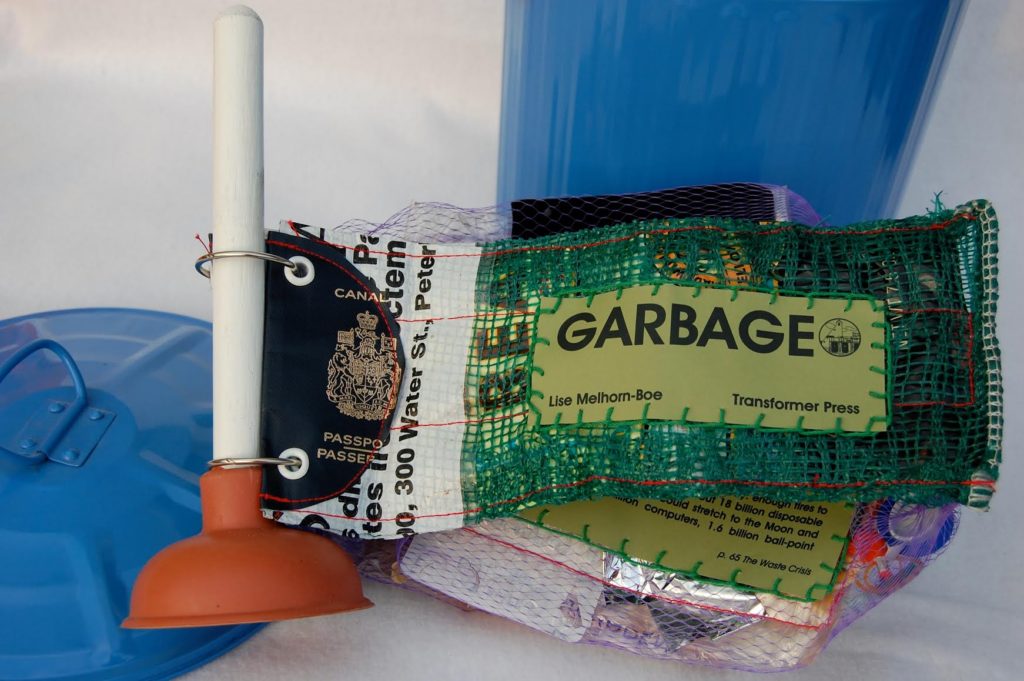
What does the text say?
The text is about what we’re doing with our garbage and how it’s impacting us. One text says that:
Unmixed streams of plastic can actually be refashioned into bottles or containers. But there isn’t much demand from their makers for recycled plastic. Virgin is so much cheaper.
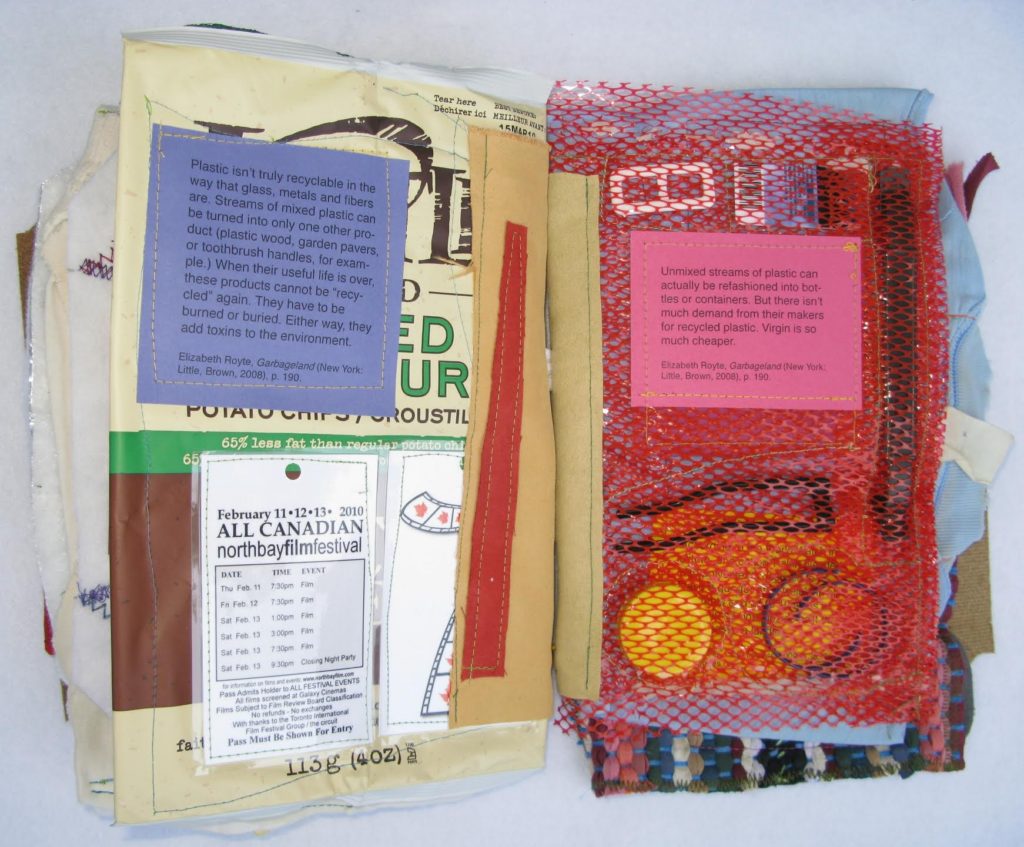
I took that text from Elizabeth Royte’s book called Garbageland. Another of the texts says that:
Canadians produce more garbage than anyone else. Each of us generates a staggering 383 kg of solid waste annually, according to Statistics Canada. In 2006, we created 35 million tonnes of trash (up eight per cent in two years).
So those are two examples from some of the text that I sewed into these garbage pieces. The concept of the garbage came first—before/then? the text—and then the collection of the garbage came after. Not that it was very difficult, there’s so much garbage. More Garbage in 2010 was just garbage that I had collected on the sidewalks, in intersections—and mittens. I found this fabulous mitten in the spring; everywhere in North Bay after the snow melts there are mittens.
If you were to do this garbage series again, do you think you would have similar things in your mesh bags almost ten years later?
Well, probably not bones and probably not the Rice Dream containers. Here in Kingston we can recycle them—Kingston says “all plastics”. So it would probably be less.
You’ve said that your garbage series was inspired by your personal health crisis—finding out you had lead toxins and other hard metals in your system and suspecting that it had caused your breast cancer. Were there any other pieces that came out of your experience with cancer?
The first book I showed to the committee to become an artist in residence at Queen’s—I was doing an art exchange with a gallery in Toronto and somebody had picked the theme of ‘landscapes’. And I thought, “I don’t do landscapes”. But I wanted to be in a show on Queen St. West in Toronto, so I had to come up with something! I ended up doing this book—this is a rock cut because I love the rock cuts along the highways up north. People do often put graffiti on the rock cuts, so my graffiti on this ‘rock cut’ is all the heavy metals that are in my body and the size of the lead and mercury are much bigger because I had a much higher concentration of those than say, tin.
I am part of these rocks, these rocks are a part of me. This is my personal landscape and it’s my body and its intersections with the environment, with nature, with rocks, with metals.
To visualize—this book is cut out in the shape of me lying down on my side, with my leg stretched out. It connects to the quote down at the bottom, which is: “there is no separation. We are the environment. So whatever we do to the environment, we do to ourselves” and that’s David Suzuki. So I am part of these rocks, these rocks are a part of me. This is my personal landscape and it’s my body and its intersections with the environment, with nature, with rocks, with metals. The rest of the garbage series came out of my research.
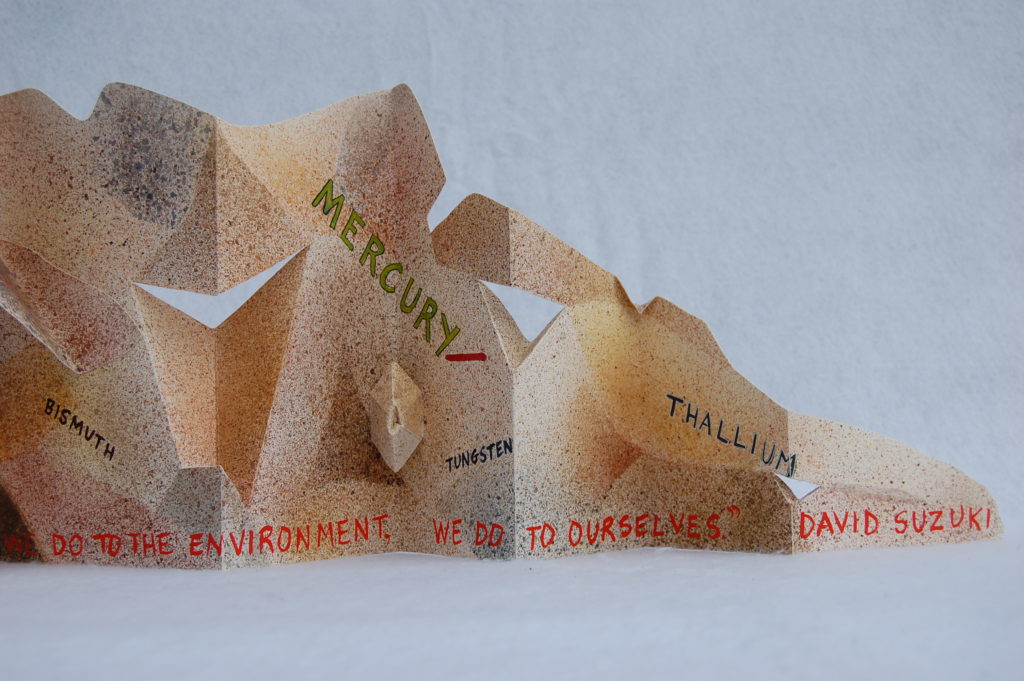
There’s another in the series that demonstrates this intersection of environment and bodies. And this one is not environmentally friendly at all because it’s computer printed—although the original was on handmade paper. My then-husband photographed me and then I blew up the photos and cut them out and glued them onto the handmade paper, wrote the text, and then had the whole thing scanned and printed in one piece.
It’s called Body Map. The text on my body discusses specific things about my body or things that I was doing in my life. The text outside of my body is more general environmental information—so, like, the text by my chest shows the environmental factors that might relate to breast cancer. Mercury vapour in the air—mercury is linked to food allergies, impaired immune systems, and thyroid malfunction. Well, I have an underactive thyroid, so I wrote this close to my thyroid. There are connections with the environment and me. Some of them are just funny—like, in 2005 I wrote that I “began to get old lady wrinkles on my knees”. I don’t think I can blame that on the environment!
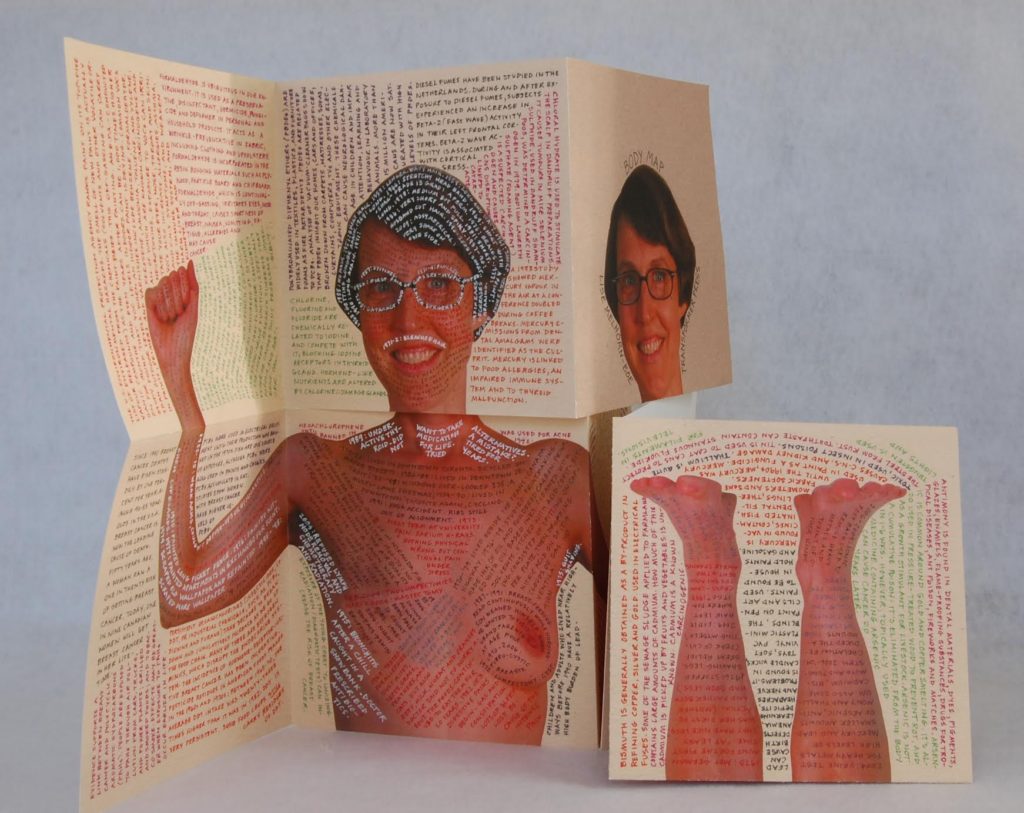
So this is your gendered experience of the environment. Thinking about environmental contaminants that are impacting bodies, they don’t impact all bodies equally.
Yes, absolutely. Women have more body fat and so the contaminants affect us more because a lot of things go to the fat. There is a difference. And then things affect children differently because they’re so much smaller, so contaminants are more impactful. I grew up in Rouyn-Noranda in Québec with the smelter belching out smoke for my entire childhood. There were days where we weren’t allowed out for recess because… well, we never had snow days or rain days. We had bad air days.
I grew up in Rouyn-Noranda in Québec with the smelter belching out smoke for my entire childhood. There were days where we weren’t allowed out for recess because… well, we never had snow days or rain days. We had bad air days.
Anyways, since I was thinking about the environment, that made me think more about the materials I was using in my art. And so I began to make a conscious effort—at least in some of the pieces—to recycle or use up materials that I already had in my possession or that I could find at charity shops. In some of the pieces, I used materials that were left over from previous art projects.
Can you show me an example of one of your recycled projects?
I had been using tablecloths for another project, so I made a meander book [a meander (or maze) book gets its name from the way the paper is cut and folded to make the pages] called What’s For Dinner? It was a tablecloth and it opens up for display into the whole tablecloth in a spiral sort of way. Each place-setting on the napkin, I’ve hand-printed something that concerns me in my environment, in our environments.
Like, this place setting talks about factory farming and antibiotics. This place setting discusses genetically modified crops. This one is about fish farming and this one in the center has to do with colour, fake colour in foods. Another place setting deals with produce that has pesticide residues.
This was really fun to do. I did several copies and they’re all different—they are all tablecloths that I’ve found and reused. Quite a bit of the stuff that I used on the place settings is things that I had around the studio. I didn’t actually have to go out and buy too much material. I’ve been keeping plastic utensils for years. If I’m travelling and I end up eating out, I’ll bring the plastic utensils home.
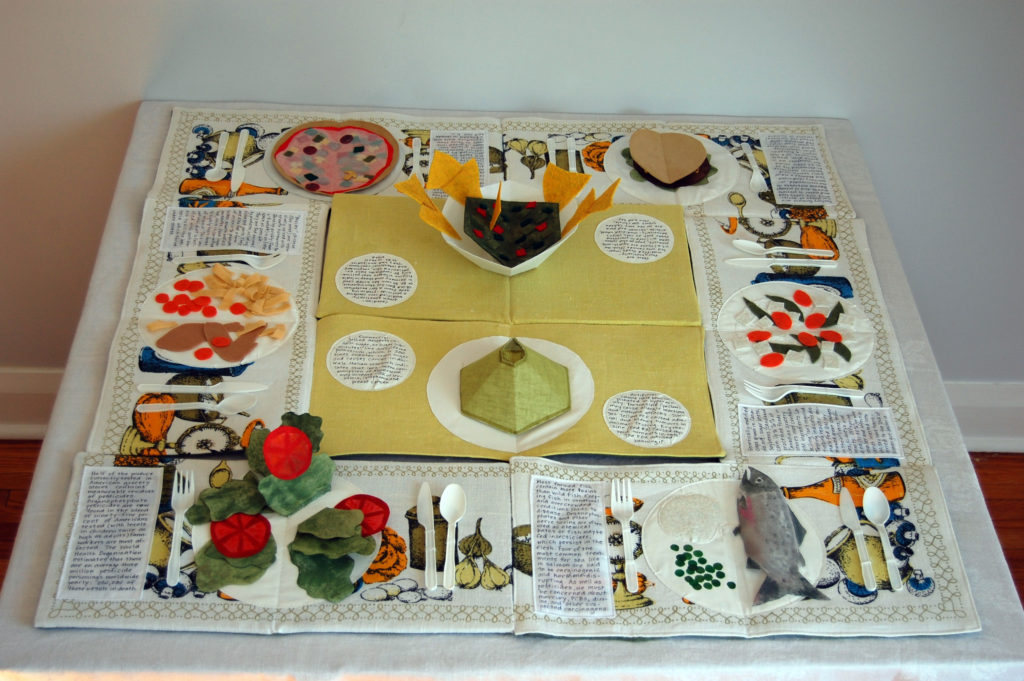
You’ve obviously made a conscious effort to recycle and reuse your materials—especially fabrics like the tablecloths. You must be very adept with a sewing machine!
I separated from my husband about five years ago and we had been living in North Bay until that time, it was much cheaper to live up there. We owned our house outright so we didn’t need a lot of money. I just worked as an artist. But once I was on my own, I needed more income so I was searching around for different ways to make a living. And somebody gave me a serger, which is a sewing machine that does a double-stitch.
So I started making these t-shirts—used t-shirts that I was cutting up and repurposing them, rejigging them. I really liked them, but it wasn’t really making money for me. It was pointless. I wasn’t making any art because I was spending all my time repurposing t-shirts and they weren’t making much money anyway, so I thought I might as well make art and not make any money.
Anyway, I gave away any t-shirts that I hadn’t cut up yet. But I had lots of pieces and so I started making The “Re” Books and I’m playing with the idea of reduce, reuse, recycle. All the books have just three words in them and they all start with re. All of the words are made out of recycled t-shirts and they’re so much fun to make—like balloon animals! Except for some of the stiffening in the letters, I didn’t have to buy anything to make these pieces.
I will be having a show at Modern Fuel, a local Kingston gallery, next spring and I hope to have an entire room filled with these books. I also do sewing for homes—I make upcycled cushions. I’ve been making these cushions from leftover pieces of upholstery fabric because I have done some upholstery for people—sewing slipcovers and cushions. I have lots of fabric and it’s all just small pieces. Perfect to reuse! I’ve been having fun with the fabrics. It grew out of thinking about recycling and how recycling has become the medium.
Even though there is a range of topics that you tackle in your art, there always seems to be some sort of repurposing and recycling of materials. And the theme of memory is often recurring. How do you think memory and remembering fits in with the environment, with your environment?
That’s a good question, I’ve never thought about that! I suppose if we remember a bit more we might be more conscious about what we are doing. Of course, it’s also thinking about the future maybe in a way more than the past. Thinking, “if I do this, how is it going to affect someone down the line?”.
I always feel that—especially with garbage—there is a conscious forgetting that happens. A reactive forgetting that as soon as you disavow something as ‘garbage’—as soon as you finish with your apple or no longer need your coffee cup, it goes out to the curb and it becomes forgotten. Maybe not for others and maybe not for others who have to deal with the garbage where it ends up—but for you, it’s gone.
It’s gone and it’s wiped away. On the other hand, just looking at someone else’s garbage is a memory right there. Garbage can tell a story. And I love telling stories.
Lise Melhorn-Boe has been working with books as an art medium for over forty years. She is especially drawn to women’s political and personal experiences and environmental concerns as they relate to human health. Lise plays with humour and adopts a playful visual aesthetic to explore more serious feminist and environmental issues.
Cassandra Kuyvenhoven is a doctoral candidate in the School of Environmental Studies at Queen’s University in Ontario, Canada. Her interests include waste management, governance, knowledge controversies, and sustainable alternatives to waste transportation.
To receive our next article by email, click here.
- The Copper Cliff area of Greater Sudbury hosts one of the greatest concentrations of mining infrastructure anywhere in the world. A mine, mill, smelter, nickel refinery, extensive slag dumps and tailings deposition areas can be viewed from the major roadways.
- The Inco Superstack, located in Copper Cliff, is the tallest chimney in Canada and the western hemisphere.
- The Copper Cliff area of Greater Sudbury hosts one of the greatest concentrations of mining infrastructure anywhere in the world. A mine, mill, smelter, nickel refinery, extensive slag dumps and tailings deposition areas can be viewed from the major roadways.
- The Inco Superstack, located in Copper Cliff, is the tallest chimney in Canada and the western hemisphere.